
One of the few restored Ottaman houses in Old Jedda - among a sea of American style high rises.
Photo gapka, Panoramio
Rihla
Book 4.1
Mekka,
Turkey, Qipchak, Serai 1331/32
Rihla
4.1
Jeddah 1332
"After the third pilgrimage [1332] I went to Judda [Jedda], intending to take ship to Yemen and India, but that plan fell through and I could get no one to join me. I stayed at Judda about forty days. There was a ship there going to Qusayr [Kosair], and I went on board to see what state it was in, but I was not satisfied. This was an act of providence, for the ship sailed and foundered in the open sea, and very few escaped.

One
of the few restored Ottaman houses in Old Jedda - among
a
sea of American style high rises.
Photo gapka,
Panoramio
"Afterwards I took ship for Aydhab, but we were driven to a roadsted called Ra's Dawa'ir [Port Sudan on the Egyptian coast of the Red Sea], from which we made our way [overland] with some Bejas through the desert to Aydhab. Thence we travelled to Edfu [on the Nile] and down the Nile to Cairo, where I stayed for a few days, then set out for Syria and passed for the second time through Gaza, Hebron, Jerusalem, Ramalah, Acre, Tripoli, and Jabala to Ladhiqiya"

Battuta's
route to Serai throught Turkey and Qipchak
Rihla
4 ,1332
Acre 1332
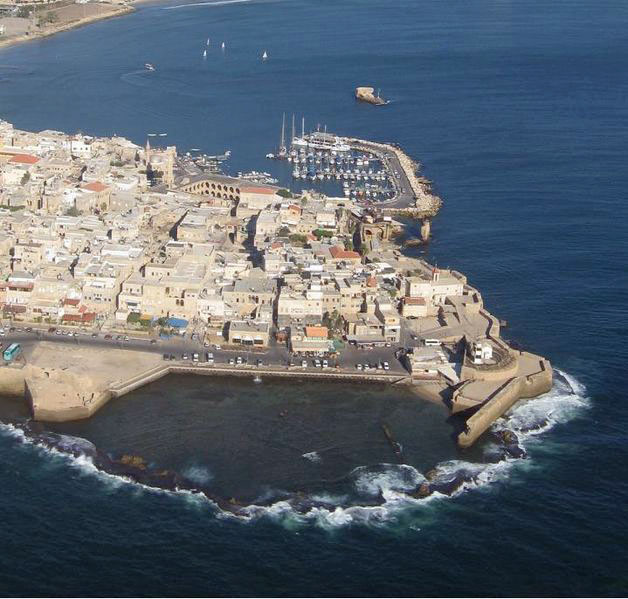
The
city of Acre on its island.
Wikipedia
Rihla
4 ,1332
Latakia 1332

Sal
ad-Din's castle in the hills above Latakia
Photo Abenaa,
Panoramio
At
Ladhiqiya we embarked on a large galley belong ing to the Genoese,
the master of which was called Martalmi'n, and set out for the
country of the Turks known as Bilad ar-Rum [Anatolia], because it was
in ancient times their land. Later on it was conquered by the
Muslims, but there are still large numbers of Christians there under
the government of the Turkmen Muslims.
We were ten nights at sea,
and the Christians treated us kindly and took no passage money(!)
from us.
Rihla
4 ,1332
Antalya
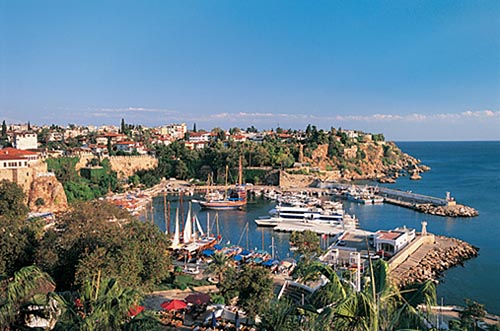
Antalya,
the old
harbour where Battuta must have arrived
"From
'Alaya I went to Antaliya [Antalya], a most beautiful city. It covers
an immense area, and though of vast bulk is one of the most
attractive towns to be seen anywhere, besides being exceedingly popu-
lous and well laid out. The town contains many orchards and produces
fine fruits, including an admirable kind of apricot, called by them
Qamar ad-Din, which has a sweet almond in its kernel. This fruit is
dried and exported to Egypt, where it is regarded as a great luxury.
in all the lands inhabited by Turkmen in Anatolia, in every
district, town, and village, there are to be found members of the
organi- zation known as the "Akfnya", Young Brotherhood.
Nowhere in the world will you find men so eager to welcome strangers,
so prompt to serve food and to satisfy the wants of others, and so
ready to suppress injustice and to kill [tyrannical] agents of police
and the miscreants who join with them. A Young Brother, or akhi
in their language, is chosen by the members of his trade [guild] to
be their leader. This organization is also known as Futu'wa, or Order
of Youth. The leader builds a hospice and furnishes it with rugs,
lamps, and other necessary appliances.
The day after our
arrival at Antaliya one of these youths came to Shaykh Shihab ad-Din
al-Hamawi and spoke to him in Turkish, which I did not understand at
that time. He was wearing old dothes, and had a felt bonnet on his
head. The shaykh said to me, " He is inviting you and your
company to eat a meal with him." I was astonished but I said "
Very well," and when the man had gone I said to the shaykh "
He is a poor man, and is not able to entertain us, and we do not like
to be a burden on him." The shaykh burst out laughing and said "
He is one of the shaykhs of the Young Brotherhood. He is a cobbler,
and a man of generous disposition. His companions, about two hundred
men belonging to different trades, have made him their leader and
have built a hospice to entertain their guests. All that they earn by
day they spend at night."
Rihla
4 ,1332
Akridur-Egirdir
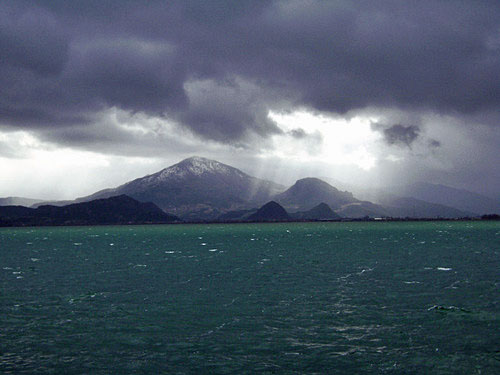
Egirdir
from the lake
Photo
ISABELLE13, Panoramio
"From
Burdur we went on to ,Sabarta_[Isparta] and then to Akridur
[Egirdir], a great and populous town with fine bazaars. There is a
lake with sweet water on which boats go in two days to Aqshahr and
Baqshshr and other towns and villages.
The sultan of Akridur is
one of the principal rulers in this country While we were there his
son died and after the burial the sultan and the students went out to
his grave for three days. I went out with them the second day and the
sultan, seeing me walking, sent me a horse with his apologies. On
reaching the madrasa I sent the horse back, but he returned it
saying, "I gave it as a gift, not as a loan." He sent me
also a robe and some money."
Rihla
4 ,1332
Qul Hisar
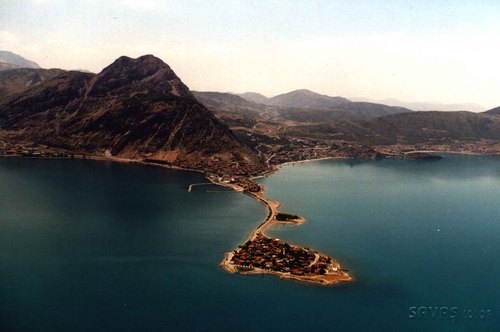
The
Lake Fortress of Egirdir
Photo,
etm, Panoramio
"We left there for the town of Qui Hisar [" Lake Fortress "], a small town completely surrounded by reed-grown water. The only way to it is by a sort of bridge between the rushes and the water, admitting only one horseman at a time. The town, which is on a hill in the midst of the lake, is impregnable. The sultan, who is the brother of the sultan of Akridur, sent some horsemen to escort us to the town of Ladhiq [Denizli], as the country was infested by a troop of brigands called Jarmiyan [Kermian] who possess a town called Kutahiya."
Rihla
4 ,1332
Ladhiq-Denizli
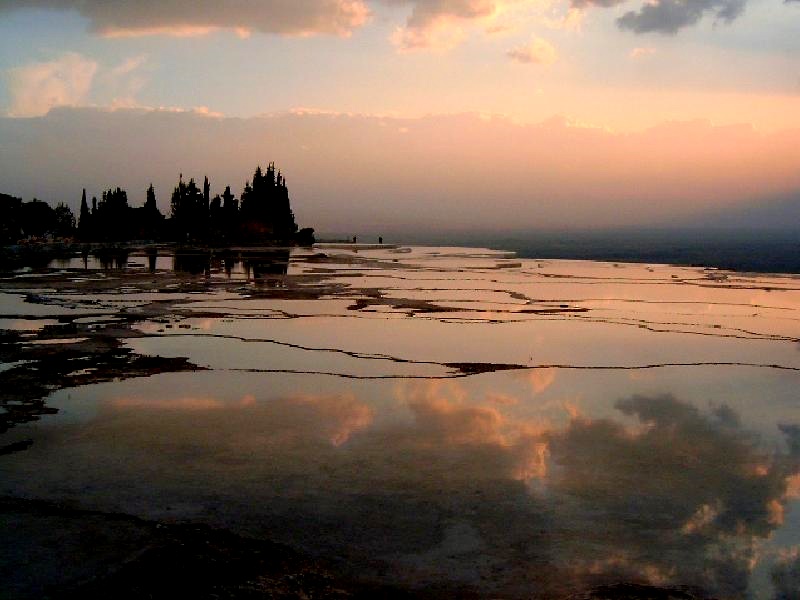
The
travertine terraces of Denizli-Pamukkale
Photo Meric
Sezer, trekeart.com
Denizli is famous for its roosters, the ruins of Hieropolis, and the travertine terraces of Pamukkale a few miles to the North.
Did
Battuta get to see them? He doesn't mention them and his eyes did not
recognize their beauty!. But in a bazaar in Ladhiq he got
dramatically involved with the fiery Turks and the custom of akh,
[instituted hospitality]. The word is related both to the Turkish
word for "generous" and the Arabic for "brother."
These fraternal societies, the"akhis" existed throughout
the land.
"Ladhiq is a most
important town, with seven cathedral mosques. In it are manufactured
matchless cotton fabrics with gold embroidered edges, which have a
very long life on account of the excellence of the cotton and of the
spinning. Most of the_workers are Greek women, for there are many
Greeks here who are subject to the Muslims and pay a poll tax to the
sultan. The definitinetive mark of the Greeks are their hats, red or
white; their women wear capacious turbans.
As we passed through
one of the bazaars, some men came down from their booths and seized
the bridles of our horses. Then certain other men quarreled with them
for doing so, and the altercation between them grew so hot that some
of them drew knives. All this time we had no idea what they were
saying [Ibn Battuta did not speak Turkish], and we began to be afraid
of them, thinking that they were the [brigands] who infest the
roads....
At length God sent us a man, a pilgrim, who knew
Arabic, and I asked what they wanted of us. He replied that they
belonged to the fityan...and that each party wanted us to lodge with
them. We were amazed at their native generosity. Finally they came to
an agreement to cast lots, and that we should lodge first with the
group whose lot was drawn [and then with the other].
We were
amazed at their generosity. This being done the prior of the first
hospice, Brother Sinan, conducted us to the bath and himself looked
after me; afterwards they served up a great banquet with sweetmeats
and many fruits. Some verses of the Koran were then read and after
that they began to chant their litany and to dance.
Battuta
describes how the brothers in every Akh-Hane danced meditation
dances. And in fact, Rumi adopted this local custom for his Dancing
Mevlana Dervishes.
"We stayed at
Ladhiq for some time, in view of the dangers of the road; then, as a
caravan was ready to set out, we travelled with them for a day and
part of the next night and reached the castle of Tavas."
Rihla
4 ,1332
Tavas
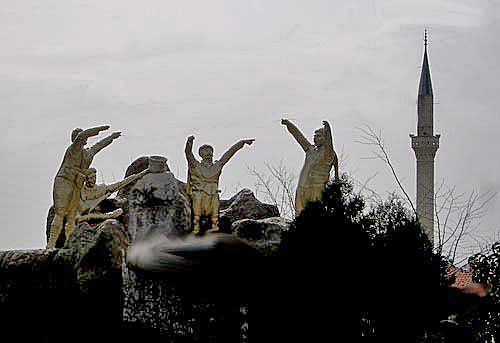
Monument
to the Dancing Dervishes at Tavas
Photo ©ahit
HOSOGLU, Panoramio
"At Tavas we spent the night outside the town and next morning, on coming to the gate, we were interrogated, from the top of the wall. The commander then came out with his troops, and after they had explored the neighbourhood for robbers, their animals were driven out. This is their practice because of brigands. We lodged in a convent of one of the Young Brotherhood, who outdid by far all that our previous hosts had done in the way of generosity, hospitality, taking us to the bath, and other praise.
Rihla
4 ,1332
Milas
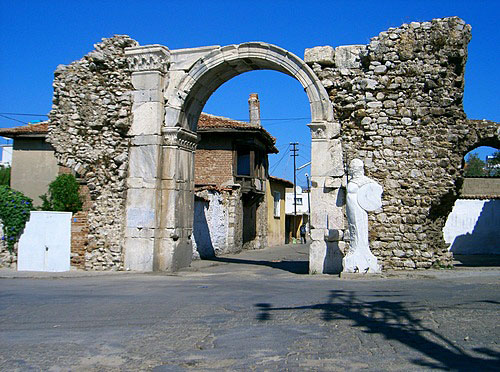
Old
city gate at Milas
Photo aktolug,
Panoramio
Rihla
4 ,1332 Mentioned but not visited
Quniya-Konya
Battuta's mysterious journey to Konya, Sivas, Amasya, and Erzerum
From
Milas Battuta - he writes in the Rihla - traveled to Konya and from
there to Nigde, Akseray, Sivas, Amasya, and Arz ar-Rum, a distance of
1800 km one way. Did the famous Simurgh of his dreams take him there,
or a flying carpet - and back? Because he reemerges in Aya Soluk
(Seljuk-Ephesos) a short time later.
We have to assume that this
excursion is fantasy or a deception inserted for the reader. All
these towns were well known in his time, Erzerum was on the main Silk
Road to India. Marco Polo had passed it twice on his journeys.
Battuta mentions Ala'eddin Rumi in Konya and a few other probable
adventures, liitle specific. The whole trip is taken care of in less
than three pages.
I have marked these town in small print, so
that the reader can convince him/herself - and continue with Batuta's
journey through western Turkey.
Rihla
4 ,1332
Aya Soluk-Selcuk-Ephesos
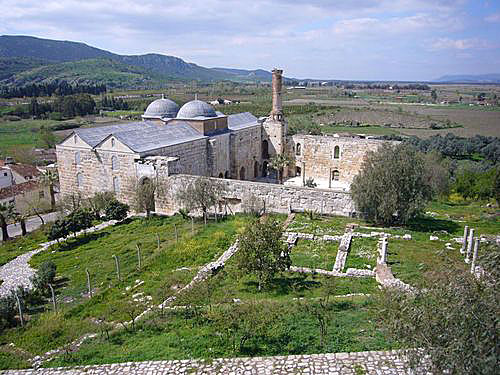
Seldjuk
Isa Bay Mosque (formerly St. John)
Photo Jean-Marc
Matthey, Panoramio
"We
went to Aya Suluq [Selcuk/Ephesus], a large and ancient town
venerated by the Greeks. It possesses a large church built of finely
hewn stones, each measuring ten or more cubits in length. The great
mosque, which was formerly a church greatly venerated by the Greeks,
is one of the most beautiful in the world.
I bought a Greek
slave girl there for forty dinars.
Rihla
4 ,1332
Bergama-Pergamon
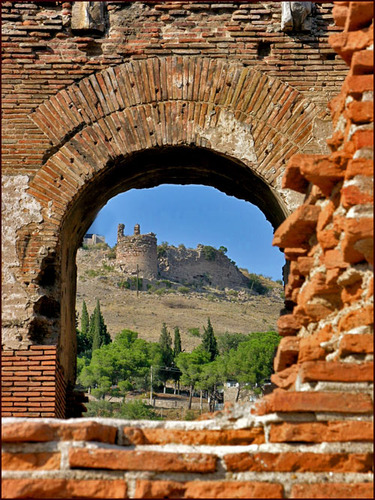
View
of the Acropolis of
Bergama.
Photo serapion,
Panororamio
Battuta is traveling along the frontier of the Ottoman controlled central area of Turkey. The fighting between the tottering Byzantine Empire and the Muslims is still very much alive. Constantinople, weakened by its having been sacking by the Venetian Fourth Crusade (1204), will only fall to the Ottomans in 1473. This is the reason why he is skirting through Bursa and the newly conquered Nicea without visiting the 50 km distant Constantinople.
Rihla
4 ,1332
Bursa 1332
"We
journeyed next to Bursa, a great city with fine bazaars and broad
streets, surrounded by orchards and running springs.
Outside it
are two thermal establishments, one for men and the other for women,
to which patients come from the most distant parts. They lodge there
for three days at a hospice which was built by one of the Turkmen
kings.
In this town I met the pious Shaykh 'Abdullah the
Egyptian, a traveller, who went all round the world, except that he
never visited China, Ceylon, the West, or Spain or the Negrolands, so
that in visiting those countries I have surpassed him.
Rihla
4 ,1332
Yaznik, Nicea, Iznik
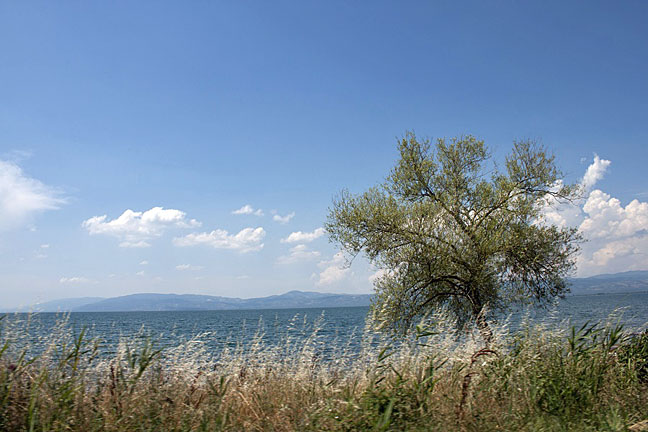
The
Lake of Iznik
Photo mutluhan
ceyhan, Panoramio
"Yaznik
lies in a lake and can be reached only by one road like a bridge
admitting only a single horseman at a time. It is in ruins and
uninhabited except for a few men in the Sultan's service. It is
defended by four walls with a moat between each pair, and is entered
over wooden drawbridges. Inside there are orchards and houses and
fields, and drinking water is obtained from wells.
I stayed
in this town forty days owing to the illness of one of my horses, but
growing impatient at the delay I left it and went on with three of my
companions and a slave girl and two slave boys. We had no one with us
who could speak Turkish well enough to interpret for us, for the
interpreter we had left us at Yaznik.
Rihla
4 ,1332
Kaynuk-Göynük
Winter 1332/33
"Kaynuk
is a small town inhabited by infidel [Christian] Greeks under Muslim
protection. So we put up at the house of an old infidel woman.
She
treated us well, and we spent that night in her house. When we
mounted our horses in the morning, the horseman whom the member of
the Brotherhood had provided us with brought a man to guide us to the
town of Muturni (Muldurnu).
This was in the season of snow and
rain. The road was obliterated by a heavy fall of snow the previous
night, so our guide went on ahead of us and we followed his tracks.
He led us over difficult and mountainous country, and a river
channel which we crossed more than thirty times. After this the guide
asked us for some money, but we said " When we reach the town we
shall give you plenty." He was not satisfied or else did not
understand. I then gave him a little money and he took it and
decamped, leaving us with no idea which way to go and with no road
visible to us.
About sunset we came to a hill on which we could
make out the track. I was afraid that both I and my com-panions might
perish, as I expected more snow to fall and the place was
uninhabited; if we dismounted we were doomed and if we went on we did
not know the road.
I had a good horse however, so I said to
myself, "If I reach safety perhaps I may contrive to save my
companions," and commending them to God, I set off. At length in
the late evening I came to some houses that were inhabited, and God
of his goodness led me to a religious house belonging to some
darwishes. I asked them to go out with me and rescue my companions.
They did so, and we all reached the convent in safety, praise be to
God Most High for our safety ! Each darwish brought us what food he
could and our distress was removed."
Rihla
4 ,1332
Mudurnu Winter 1332/33
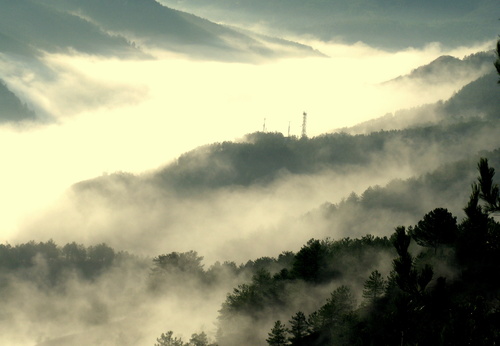
Mudurnu
under the Winter fog.
Photo Bayram
Kamci, Panoramio
We
set out next morning and reached Muturni [Mudurnu], where we fell in
with a Turkish pilgrim who knew - Arabic! We besought him to travel
with us to Kastamonu, which is ten days' journey from there; I gave
him an Egyptian robe of mine and some money for current expenses,
which he left with his family, and assigned him a mount, promising
him a good reward.
He turned out to be a wealthy man, but of mean
character. We used to give him money for our expenses, and he would
appropriate the left over money. We put up with him because of our
difficulties in not knowing Turkish, but things went so far that we
used to say to him in the evenings "Well, Hajji, how much have
you stolen today ?" He would reply "So and so much"
and we would laugh and make the best of it.
Rihla
4, Winter 1332/33
Qastamuniya,
Kastamonu

Kastamonu
Photo KadirSsivrioglu
We
went on through a small town named Burlu [Bolu?] to Qastamuniya, a
very large and fine town, in which goods are plentiful, and prices
cheaper than I have ever seen elsewhere.
We stayed in the convent
of a very deaf shaykh and I saw an astonishing thing in connection
with him. One of his students used to write with his finger in the
air or on the ground and he would understand and reply. Sometimes
long stories were told him in this way. We remained here about forty
days [to wait out the winter].
Rihla
4 , Spring 1333
Sarup-Sinope Spring 1333
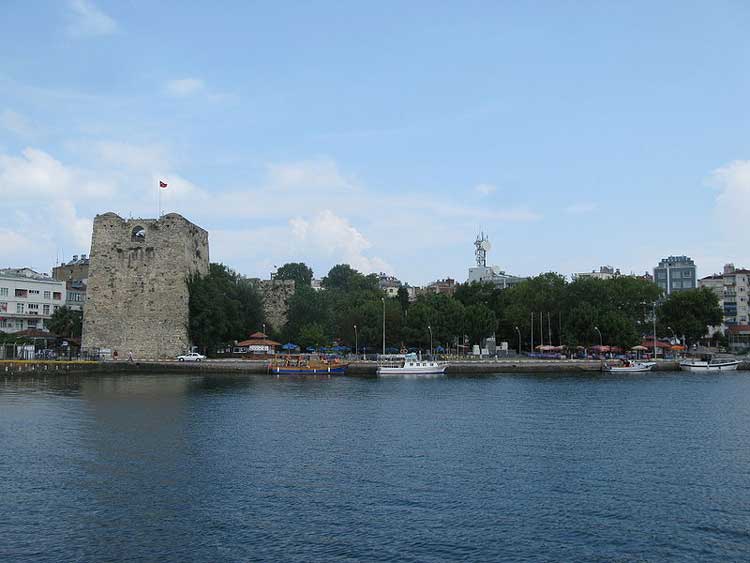
Sinope
Photo mthanas.de
"We stayed at Sanub [Sinope] about forty days waiting for the weather to become favourable for sailing to the town of Qiram [in the Crimea]. Then we hired a vessel belonging to the Greeks and waited another eleven days for a favourable wind."
Voyage acrosss the Black Sea
Rihla
4 , Spring 1333
Blown by a storm

Winter
Storm
over the Black Sea, Painting by Cavaliere Pietro Tempesta
Photo
Wikimedia
At
length we set sail, but after travelling for three nights, we were
beset in mid-sea by a terrible tempest. The storm raged with
unparalleled fury, then the wind changed and drove us back nearly to
Sanub.
The weather cleared and we set out again, and after
another tempest like the former, we at length saw the hills on the
land. We made for a harbour called Karsh [Kerch], intending to enter
it, but some people on the hill made signs to us not to enter, and
fearing that there were enemy vessels in the port, we turned back
along the coast.
Rihla
4, 1332
Karsh-Kerch

Entry
to Kerch
Photo Vladymyr
Bysov, Panoramio
"We made for a harbour called Karsh [Kerch], intending to enter it, but some people on the hill made signs to us not to enter, and fearing that there were enemy vessels in the port, we turned back along the coast."
Rihla
4, 1332
Stranded in the Crimean

The
south coast of the Crimean.
Photo Andrey
Jitkov, Panoramio
"As
we approached the land I said to the master of the ship "I want
to descend here," so he put me ashore. The place was in the
Qipchaq desert [steppe] which is green and verdant, but flat and
treeless. There is no firewood so they make fires of dung, and you
will see even the highest of them picking it up and putting it in the
skirts of their garments.
The only method of travelling in this
desert is in waggons; it extends for six months' journey, of which
three are in the territories of Sultan Muhammad Uzbeg.
The day
after our arrival one of the merchants in our company hired some
waggons from the Qipchaqs who inhabit this desert, and who are
Christians, and we came to Kafa [Kaffa], a large town extending along
the sea-coast, inhabited by Christians, mostly Genoese....
Rihla
4, 1332
Kaffa-Sudak
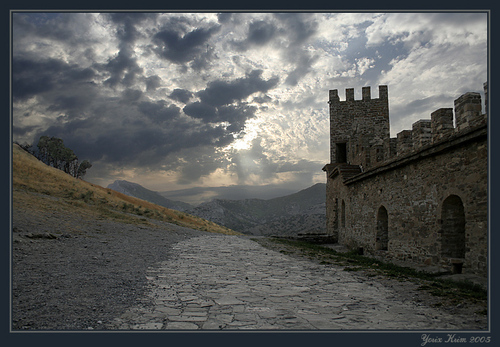
Sudak
the
Genoese Fort.
Photo Yorix,
Panoramio
We
stayed at Kaffa in the mosque of the Muslims. An hour after our
arrival we heard bells ringing on all sides. As I had never heard
bells before, I was alarmed and made my companions ascend the minaret
and read the Koran and issue the call to prayer. They did so, when
suddenly a man entered wearing armour and weapons and greeted us. He
told us that he was the qadi of the Muslims there, and said "When
I heard the reading and the call to prayer, I feared for your safety
and came as you see." Then he went away, but no evil befell
us.
The next day the governor came to us and entertained us to
a meal, then we went round the city and found it provided with fine
bazaars. All the inhabitants are infidels. We went down to the port
and saw a magnificent harbour with about two hundred vessels in it,
ships of war and trading vessels, small and large, for it is one of
the most notable harbours in the world.
Rihla
4, 1332
Al-Qiram Qipchaq
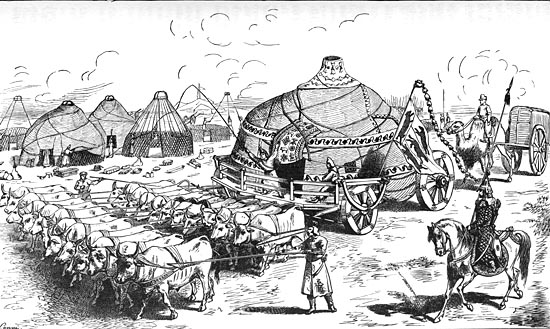
A
Kipchak wagon. Far too many oxen pulling the light yurt, two or four
would have been enough. But this old illustration from Marco Polo's
travels was intended to impress the gullible Western readers. The
sedan-chair is pulled by a dromedary(!) to indicate Central Asia.
We hired a waggon and travelled to the
town of Al- Qiram, which forms part of the Qupchak territories of
Sultan Uzbeg Khan and has a governor called Tuluktumur.
These
waggons have four large wheels and are drawn by two or more(sic!)
horses, or by oxen or camels, according to their weight. The driver
rides on one of the horses and carries a whip or wooden goad.
On
the wagon is a kind of cupola made of wooden laths tied together with
thin strips of hide; this is light to carry, and covered with felt or
blanket-cloth, and in it there are grilled windows. The person who is
inside the tent can see [other] persons without their seeing him, and
he can employ himself in it as he likes, sleeping or eating or
reading or writing.... Those of the wagons that carry the baggage,
the provisions and the chests of eatables are covered with a sort of
tent much as we have described, with a lock in it.... We saw a vast
city on the move with its inhabitants, with mosques and bazaars in
it, and the smoke of the kitchens rising in the air, for they cook
while on the march.
Rihla
4, 1332
Serai-al-Jadid 1333
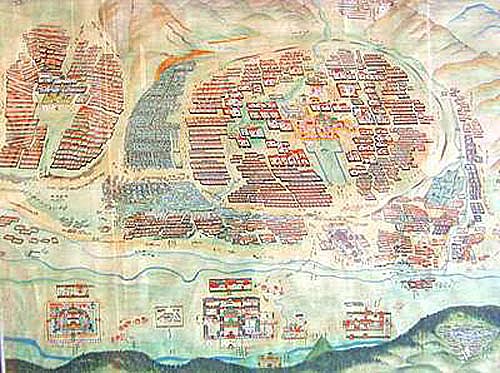
Seray
of Uzbek Khan
hla
4, 1332
Bishdagh Uzbek Khan's Ordu
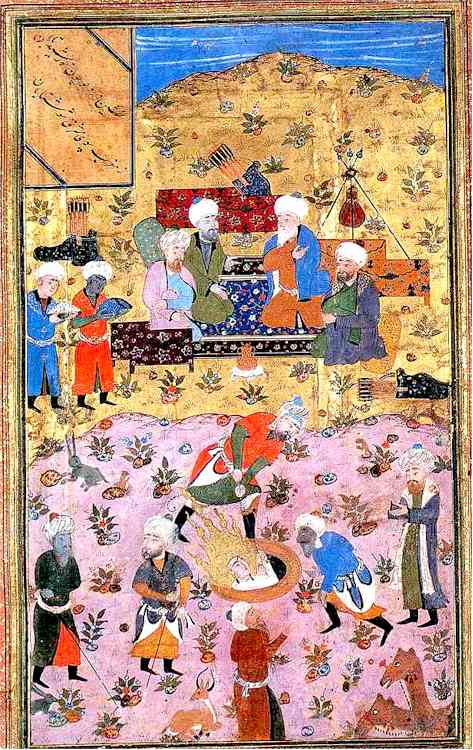
Persian
miniature of Uzbek Khan
Photo spongobongo.com
Uzbek Khan's Camp
"We
then prepared for the journey to the sultan's Ordu (camp), which was
four days' march [to] a place called Bishdagh, which means "Five
mountains."
We arrived at the camp on the first day of
Ramadan and found that it was moving to the neighbourhood from which
we had just come, so we returned thither. I set up my tent on a hill
there, fixing a standard in the ground in front of it, and drew up
the horses and waggons behind. Thereupon the mahalla approached (the
name they give to it is the ordu) and we saw a vast town on the move
with all its inhabitants, containing mosques and bazaars, the smoke
from the kitchens rising in the air (for they cook while on the
march), and horse-drawn waggons transporting them. On reaching the
encampment they took the tents off the waggons and set them upon the
ground, for they were very light, and they did the same with the
mosques and shops.
The sultan's khatuns [wives] passed by us, each
separately with her own retinue. The fourth of them, as she passed,
saw the tent on top of the hill [i.e., Ibn Battuta's tent] with the
standard in front of it, which is the mark of a new arrival, and sent
pages and maidens to greet me and convey her salutations, herself
halting to wait for them.
I sent her a gift by one of my
companions and the chamberlain of the amir Tuluktumur. She accepted
it as a blessing and gave orders that I should be taken under her
protection, then went on. Afterwards the sultan arrived and camped
with his mahalla separately."
Meeting Uzbek Khan
"The day after my arrival I
visited the Khan in the afternoon at a ceremonial audience; a great
banquet was prepared and we broke our fast in his presence. These
Turks do not follow the custom of assigning a lodging to visitors and
giving them money for their expenses, but they send him sheep and
horses for slaughtering and skins of qumizz, which is their form of
benefaction.
Every Friday, after the midday prayer, the
sultan holds an audience in a pavilion called the Golden Pavilion,
which is richly decorated. In the centre there is a wooden throne
covered with silver-gilt plates, the legs being of pure silver set
with jewels at the top. The sultan sits on the throne, having on his
right the Khatun Taytughli with the khatun Kebek on her right, and on
his left the khatun Bayalun with the khatun Urduja on her left. Below
the throne stand the sultan's sons, the elder on the right and the
younger on the left, and his daughter sits in front of him. He rises
to meet each Khatun as she arrives and takes her by the hand until
she mounts to the throne. All this takes place in view of the whole
people, without any screening."
Rihla
4, 1332
The Amazing Wives of Uzbek Khan

A
Northern Uzbek woman in the door of her yurt.
Three-plate color
photo of ~1907 ! Prokudin's
Pre-Revolutionary Photographs
Battuta
about the Women of the Qipchak Turks:
"A
remarkable thing which I saw in this country was the respect shown to
women by the Turks, for they hold a more dignified position than the
men.
The first time that I saw a princess was when, on leaving
Qiram, I saw the wife of the amir in her waggon. The entire waggon
was covered with rich blue woollen cloth, and the windows and doors
of the tent were open.
With the princess were four maidens,
exquisitely beautiful and richly dressed, and behind her were a
number of waggons with maidens belonging to her suite.
When she
came near the amir's camp she alighted with about thirty of the
maidens who carried her train. On her garments there were loops, of
which each maiden took one, and lifted her train clear of the ground
on all sides, and she walked in this stately manner.
When she
reached the amir he rose before her and greeted her and sat her
beside him, with the maidens standing round her. Skins of qumizz were
brought and she, pouring some into a cup, knelt before him and gave
it to him, afterwards pouring out a cup for his brother. Then the
amir poured out a cup for her and food was brought in and she ate
with him. He then gave her a robe and she withdrew.
I saw also
the wives of the merchants and commonality.
One of them will sit in a waggon which is being drawn by horses,
attended by three or four maidens to carry her train, and on her head
she wears a conical headdress incrusted with pearls and surmounted by
peacock feathers. The windows of the tent are open and her face is
visible, for the Turkish women do not veil themselves. Sometimes a
woman will be accompanied by her husband and anyone seeing him would
take him for one of her servants; he has no garment other than a
sheep's wool cloak and a high cap to match."
Uzbek Khan's Four
Wives.
"On the morrow of my
interview with the sultan I visited the principal khatun Taytughli
[Georgian?],
who is the queen and the mother of the sultan's two sons. She was
sitting in the midst of ten aged women, who appeared to be servants
of hers, and had in front of her about fifty young maidens with gold
and silver salvers filled with cherries which they were cleaning. The
khatun also had a golden tray filled with cherries in front of her
and was cleaning them.
She ordered qumizz to be brought and with
her own hand poured out a cupful and gave it to me, which is the
highest of honours in their estimation. I had never drunk qumizz
before, but there was nothing for me but to accept it. I tasted it,
but found it disagreeable and passed it on to one of my companions.
The following day we visited the second khatun Kebek and found
her sitting on a divan reading the holy Koran. She also served me
with qumizz.
The third khatun Bayalun is the daughter [almost
certainly an illegitimate daughter] of
the Emperor of Constantinople the Great. On visiting her we found her
sitting on a throne set with jewels, with about a hundred maidens,
Greek, Turkish and Nubian, standing or sitting in front of her.
Behind her were eunuchs and in front of her Greek chamberlains.
She
asked how we were and about our journey and the distance of our
native lands, and wept, in pity and compassion, wiping her face with
a handkerchief that lay before her.
She ordered food to be served
and we ate in her presence, and when we desired to leave she said "Do
not sever relations with us, but come often to us and inform us of
your needs."
She showed great kindness to us and after we
had gone sent us food, a great quantity of bread, butter, sheep,
money, a magnificent robe and thirteen horses, three good ones and
ten of the ordinary sort. It was with this khatun that I made my
journey to Constantinople the Great, as we shall relate hereafter.
The fourth khatun is one of the best, most amiable and
sympathetic of princesses. We visited her and she showed us a
kindness and generosity that cannot be surpassed, may God reward
her!"